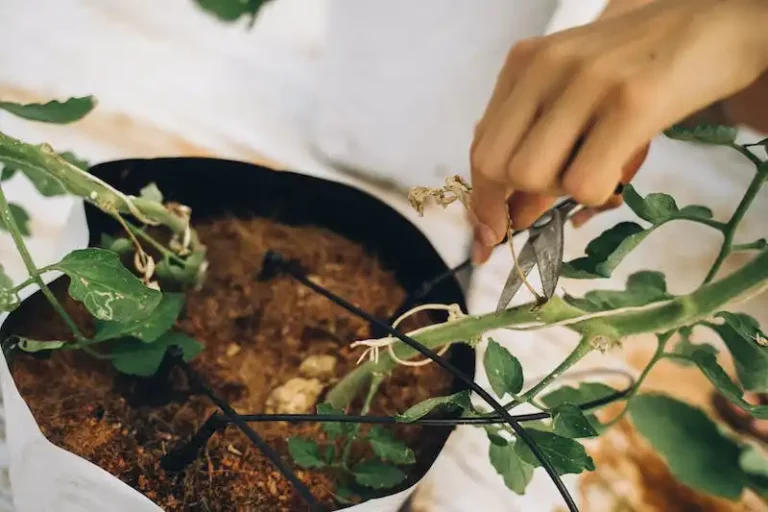MSU Extension provides valuable resources and information for gardeners and farmers alike. They offer assistance with common problems such as soil nutrition, pests, and plant diseases. Their expertise is especially helpful for those looking to improve their crops and maximize yields.
Growing plants in healthy soil is essential for successful gardening. MSU Extension offers guidance on soil preparation and amendment, helping gardeners create the ideal environment for their plants. They also provide advice on seed selection, thinning seedlings, and proper spacing to promote healthy growth.
Watering is another important aspect of plant care, and MSU Extension offers valuable tips on when and how much to water. They emphasize the significance of proper watering to ensure plants receive enough moisture without becoming waterlogged.
Harvesting and storage techniques are also covered by MSU Extension. They provide guidance on when to pick different types of vegetables, as well as tips for storing them properly to prolong freshness. Additionally, they offer advice on post-harvest care, including cleaning and preservation methods.
MSU Extension is an excellent resource for gardeners and farmers seeking support and information. Whether it’s about soil fertility, pest control, or plant care, they have answers to a wide range of questions. Their comprehensive overview of gardening topics makes them a trusted source for anyone wanting to improve their gardening skills.
How to Plant and Grow Beets
Beets are a popular crop to plant in the fall. They are easy to grow and don’t require much maintenance, making them a great addition to any home garden. Here are some tips on how to successfully plant and grow beets.
Selection and Preparation
When selecting beet seeds, look for varieties that are well-suited to your area’s climate and soil conditions. Beets prefer a loamy soil that is well-drained and rich in organic matter. Before planting, prepare the soil by removing any weeds and rocks and adding compost or well-rotted manure for added nutrition.
Planting
Beets can be planted directly in the garden or started indoors in pots for earlier maturity. If planting directly in the garden, sow the seeds about half an inch deep and 1-2 inches apart in rows. Thinning is essential to ensure proper growth, so once the seedlings are a few inches tall, thin them to about 3-4 inches apart.
Beets are a great companion plant to radishes, as they help contribute to the overall health and growth of both crops.
Growth and Care
Beets prefer cooler temperatures, so they grow best in spring or fall. They require regular watering, especially during dry spells, to ensure they receive plenty of moisture. Mulching around the plants can help conserve moisture and suppress weed growth.
Fertilization is important for beet growth. However, be careful not to over-fertilize, as this can result in excessive foliar growth and smaller roots. A balanced fertilizer with equal amounts of nitrogen, phosphorus, and potassium is recommended.
Harvesting
Beets can be harvested once they reach the desired size, usually around 1-2 inches in diameter. Simply loosen the soil around the beet and gently pull it out. The leaves can also be harvested and cooked, much like spinach. Beets can be stored for several months in a cool, dry area.
Remember to save some of the beets for propagating in the next planting season. This will ensure a continuous and abundant beet harvest.
Overall, beets are a versatile and nutritious vegetable that can be enjoyed in various ways. Whether you prefer them cooked or pickled, planting and growing your own beets is a rewarding experience that allows you to enjoy the fresh, vibrant flavors of this root vegetable throughout the year.
Beets Overview
Beets are a versatile vegetable that can be grown in several different ways. They are frequently used in a variety of dishes and are known for their earthy flavor. Before planting beets, some preparation is required to ensure they grow properly and yield a bountiful harvest.
Beets are biennial plants that typically take around 55 to 70 days to reach maturity. They can be grown directly in the ground or in pots, making them suitable for gardeners with limited space. If growing in pots, make sure to select a variety that is suitable for container gardening.
When selecting a variety of beets to grow, consider the climate and growing zone you are in. Beets are cool-season vegetables and can withstand frost. Some varieties are more tolerant to colder temperatures, making them suitable for fall and winter harvests.
In terms of soil, beets prefer a well-drained and loamy soil. Before planting, it is recommended to test the soil to determine its pH level and nutrient content. Beets are not heavy feeders, so excessive fertilizer use is not necessary. They may benefit from adding compost or well-rotted manure to the soil before planting.
Beets require adequate spacing to grow properly. Plant beets about 3 to 4 inches apart and leave around 12 to 18 inches between rows. This spacing ensures that the plants have enough room to develop their roots without overcrowding.
Caring for beets involves regular watering, especially during dry spells. Beets prefer evenly moist soil, so make sure to water deeply to encourage deep root growth. It is also important to keep the soil weed-free to reduce competition for nutrients.
Throughout the growing season, beets can be harvested for their greens, which can be picked and enjoyed before the roots reach maturity. When harvesting the roots, use a garden fork to gently lift them out of the ground. Beets can be harvested at any size, but they are typically sweeter and more tender when harvested between 1 and 3 inches in diameter.
Beets can be susceptible to certain diseases and pests, such as aphids. To prevent these problems, make sure to rotate crops and keep the garden clean. Additionally, beets benefit from a consistent temperature of around 60 to 65 degrees Fahrenheit and high humidity levels.
Overall, beets are a versatile and nutritious vegetable that can be enjoyed in various dishes. With proper care and attention, you can successfully grow your own beets and contribute to a bountiful harvest.
Planting Tips
When it comes to planting, here are some helpful tips to ensure successful growth and harvest of your beet plants:
- Choose a variety of beet that suits your growing conditions and preferences. Some varieties are more tender and better suited for garden growing, while others are hardier and can tolerate colder temperatures.
- Plant beet seeds in rich, well-draining soil. Prepare the soil by loosening it to a depth of about 6 inches and incorporating organic matter for an earthy nutrient boost.
- If you have limited garden space or want to avoid bending over, consider planting beets in a raised square-foot garden bed.
- Consult local planting guidelines or the MSU Extension for recommendations on the best time to plant beets in your area. In general, beets can be planted in the spring once the soil temperature reaches above 40 degrees Fahrenheit.
- Plant beet seeds about half an inch deep in rows that are 12 to 18 inches apart.
- Avoid overcrowding by thinning out seedlings when they reach about 2 inches in height. Leave about 3 to 4 inches of space between plants to allow them to mature properly.
- Beets need consistent watering to thrive. Keep the soil evenly moist, but not waterlogged. A regular irrigation schedule is important, especially during dry spells.
- Protect your beet plants from common pests such as aphids, leafhoppers, and beetles. Regularly inspect plants for any signs of infestation and take appropriate measures to control them.
- Beets are a self-pollinating plant, but if you want to encourage better pollination and increase the chances of a productive harvest, you can gently shake the plants to release the pollen.
- Monitor the temperature throughout the growing season. Beets are susceptible to bolting, or prematurely going to seed, in hot temperatures. Provide shade or provide protection from extreme heat to prevent this.
- Frequent weeding is necessary to keep your beet plants healthy. Remove weeds that compete for nutrients, water, and space.
- Harvest beets when they have reached the desired size. Use a garden fork or hand trowel to carefully lift them out of the ground. Beet greens can also be harvested for salads or cooking.
- Store harvested beets in a cool, dark place to prolong their freshness. They can be stored for several weeks in a refrigerator or root cellar.
- If you encounter any problems with your beet plants or have specific care questions, consult the MSU Extension or a local farm for guidance and support.
Following these planting tips will help you cultivate a thriving beet garden and enjoy a bountiful harvest this fall or winter.
Caring for Beets
Beets are a tender and delicate plant that requires proper care to ensure a successful harvest. Here are some key factors to consider when caring for beets:
Planting
- Beets should be planted in well-drained, fertile soils with a pH level between 6.5 and 7.5.
- Make sure to choose a planting area that receives full sun, as beets require at least six to eight hours of light per day.
- Sow beet seeds directly into the garden when the soil has reached a temperature of at least 45 degrees Fahrenheit.
- Beets can also be started indoors in pots, but they should be transplanted to the garden once they have reached a diameter of about one inch.
Watering
- Beets need regular watering to maintain soil moisture, especially during dry periods.
- Water deeply and infrequently to encourage deep root growth and prevent shallow, fibrous roots.
- Make sure to water the plants evenly to avoid splitting and cracking of the roots.
- Be careful not to overwater, as this can lead to root rot and other diseases.
Weeds and Pruning
- Keep the planting area free from weeds, as they can compete with beets for nutrients and water.
- Pruning is not typically needed for beet plants unless they become overcrowded or some of the leaves show signs of disease or damage.
Fertilizing
- Perform a soil test to determine the nutrient content of the soil before planting.
- Fertilize the soil with a balanced fertilizer that includes boron, as beets are known to require this element for proper growth and development.
- Apply fertilizers according to the instructions on the package and avoid over-fertilization, as this can lead to excessive foliage growth and reduced root development.
Support and Humidity
- Beets do not require support, as they have shallow roots and do not typically grow tall.
- Provide a humid growing environment by mulching around the plants to retain moisture in the soil.
Harvesting
- Beets can be harvested when they have reached maturity, which is typically around 60-70 days after planting.
- The leaves of the beet should be bright green and healthy, and the roots should be firm and smooth.
- Gently pick the beets from the soil, being careful not to damage the roots.
By following these guidelines, you can ensure that your beets grow well and provide you with a great harvest.




